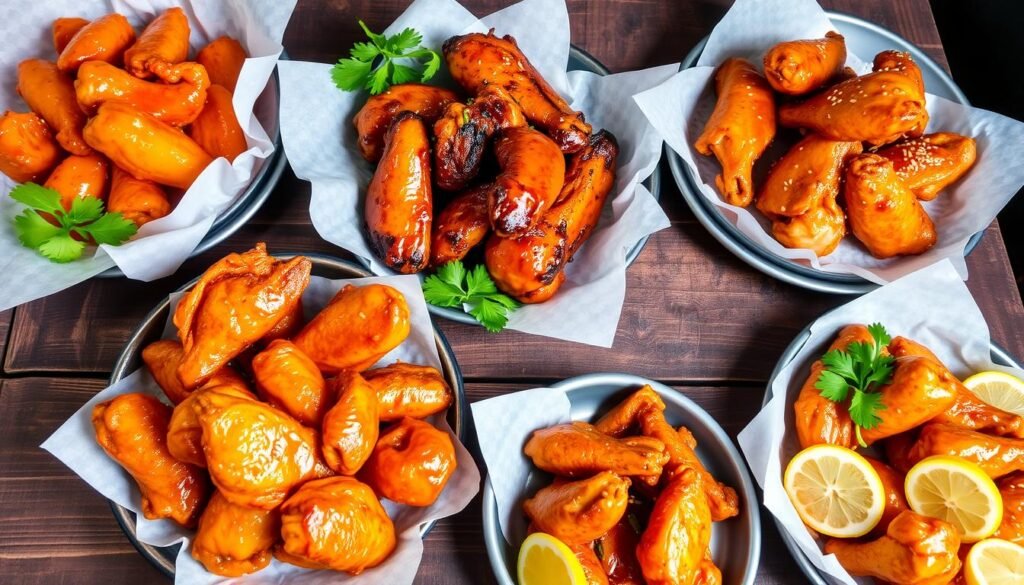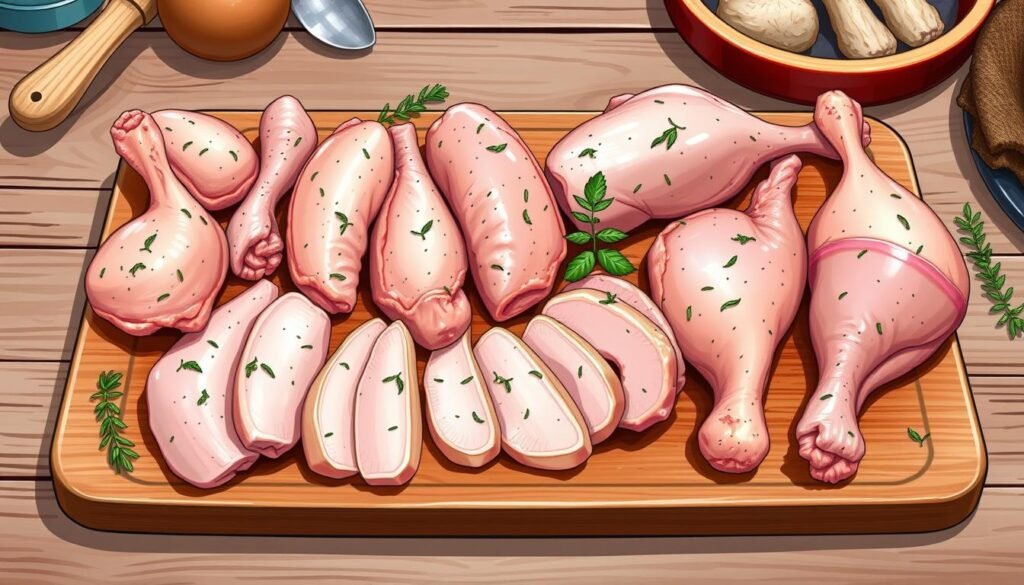Chicken wings are a favorite dish for many, loved for their tasty flavor and crunchy texture. But, the calories in chicken wings can change a lot based on how they’re cooked. In this article, we’ll look into the calorie counts of chicken wings. We’ll explore the differences in calories for various cooking methods and sizes.
Key Takeaways
- The average calorie content of 10 chicken wings (across all preparation styles) is 1,165 calories.
- Fried chicken wings contain significantly more calories and fat than grilled or baked wings.
- The type and amount of sauces and dips used can greatly impact the overall calorie count of chicken wings.
- Chicken wings are a good source of protein, with an average of 60-68 grams of protein per 10 wings.
- Moderation and portion control are crucial when enjoying chicken wings as part of a balanced diet.
Introduction to Chicken Wings
Chicken wings have won over people worldwide. They are loved for their juicy meat, crispy skin, and many flavors. You can find them at sports events and family dinners.
Popularity and Versatility of Chicken Wings
Chicken wings are a big hit in cooking. They come in many popular chicken wing dishes for different tastes. You can enjoy them grilled, baked, or fried, making them perfect for any meal.
| Cooking Method | Calorie Range (per 4-5 wings) |
|---|---|
| Fried | 400-600 calories |
| Baked | 200-300 calories |
| Grilled | 150-250 calories |
Chicken wings are great in many dishes, like salads and soups. Their flexibility makes them a favorite among food lovers.
“Chicken wings are the ultimate party food – they’re delicious, easy to eat, and perfect for sharing with friends and family.”

Chicken wings offer a wide range of popular chicken wing dishes and ways to enjoy chicken wings. They are sure to please your taste buds, whether you like classic or new flavors.
Calories in Different Cuts of Chicken
Not all chicken cuts are the same when it comes to calories. Chicken breasts, thighs, wings, and drumsticks have different calorie counts. Knowing these differences helps you choose better and control your calorie intake.
Chicken Breast: 165 Calories per 3.5 oz.
Chicken breasts are the leanest part, with about 165 calories in 3.5 ounces. They are great for those watching calories but still want good protein.
Chicken Thigh: 179 Calories per 3.5 oz.
Chicken thighs have more fat and calories than breasts, with about 179 calories in 3.5 ounces. They taste richer and have more nutrients like selenium and niacin.
Chicken Wings: 203 Calories per 3.5 oz.
Chicken wings have the most calories, with about 203 calories in 3.5 ounces. This is because they have more fat in the skin and are denser.
Chicken Drumstick: 155 Calories per 3.5 oz.
Chicken drumsticks, or legs, have fewer calories, with about 155 calories in 3.5 ounces. They are a good mix of protein, fat, and nutrients, making them versatile.
| Chicken Cut | Calories per 3.5 oz (100g) | Protein (g) | Fat (g) | Sodium (mg) | Iron (mg) |
|---|---|---|---|---|---|
| Chicken Breast (Skinless, Boneless) | 165 | 31 | 3.6 | 74 | 1 |
| Chicken Thigh (Skinless, Boneless) | 209 | 25 | 10.9 | 84 | 1.3 |
| Chicken Wing (Skinless) | 203 | 30 | 8.1 | 82 | 1.3 |
| Chicken Drumstick (Skinless) | 175 | 27 | 5.7 | 90 | 1.3 |

Understanding the calorie and nutritional differences in chicken cuts helps you make better choices. This way, you can meet your dietary needs and preferences.
Chicken Wings Calories: What You Need to Know
Calorie Breakdown of Chicken Wings
Chicken wings are a favorite dish, but knowing their calories is key. A single skinless and boneless chicken wing has about 203 calories for 3.5 ounces. They are rich in protein, with 30.5 grams per wing, but also have 8.1 grams of fat.
The calorie mix in chicken wings is interesting. 64% of their calories come from protein, and 36% from fat. This shows they are high in protein but also in fat, which can add to calorie count if eaten too much.
Impact of Skin on Calorie Content
The skin on chicken wings greatly increases their calorie count. A medium-sized wing with skin has about 92 calories, while a skinless wing has just 40. The skin adds a lot of calories and fat.
It’s crucial to watch the calories and fat, especially with skin on. Choosing skinless wings or grilled options can lower the calorie count from this tasty snack or appetizer.
Cooking Methods and Their Impact on Calories
The way you cook chicken wings can change their calorie count. Knowing the difference between frying and grilling, and how sauces and coatings affect them, is important. This knowledge helps you enjoy chicken wings in a healthier way.
Fried vs. Grilled Wings
Fried chicken wings have more calories and fat than grilled ones. Deep-frying makes the wings soak up a lot of oil, making them high in calories. On the other hand, grilling wings is healthier. It lets excess fat drip away, lowering the calorie count.
Sauces and Coatings
The sauce or coating you choose can greatly affect the calories in chicken wings. Sugary sauces like barbecue and teriyaki add a lot of calories. But, using a light, vinegar-based sauce or a dry rub can keep calories lower.
A 2019 review in the American Journal of Lifestyle Medicine found that eating too many AGEs can raise the risk of diseases like diabetes and Alzheimer’s. Choosing healthier ways to cook chicken wings can help reduce the impact of sauces on calories. This way, you can enjoy chicken wings while keeping your health in mind.
“The main benefit of air frying over deep frying is the reduction in the amount of oil used in cooking, which results in a healthier finished product with reduced inflammation and potentially decreased risk for chronic diseases.”
Whether you like fried or grilled wings, paying attention to cooking methods and sauces is key. It makes your meal healthier and more enjoyable.
Dips and Their Calorie Contribution
Chicken wings are a hit for game day snacks and appetizers. But, the dips we use can really up the calorie and fat count. Ranch and bleu cheese dips are two common ones that add a lot of calories.
Ranch Dip: 140 Calories per 2 Tbsp
A 2-tablespoon serving of ranch dip has 140 calories. It’s creamy and tangy, made with mayonnaise, sour cream, and seasonings. This mix makes it high in calories and fat.
Bleu Cheese Dip: 150 Calories per 2 Tbsp
Also, a 2-tablespoon serving of bleu cheese dip has 150 calories. It’s rich and tangy, with crumbled bleu cheese, mayonnaise, and more. This makes it a high-calorie choice for chicken wings.
These dips can add a lot of calories to your meal, especially if you love dipping. Choosing low-fat or Greek yogurt-based dips can help. They let you enjoy chicken wings without too many calories or fat.
| Dip | Calories per 2 Tbsp |
|---|---|
| Ranch | 140 |
| Bleu Cheese | 150 |
| Low-fat or Greek Yogurt-based Dip | 60-80 |
By watching the calories in your dips, you can still enjoy chicken wings. This way, you don’t ruin your diet goals.
Healthier Alternatives for Enjoying Chicken Wings
Looking for a way to enjoy chicken wings without the extra calories? There are healthier options out there. By changing how you cook and what you use, you can still enjoy these tasty bites. This way, you can keep your diet balanced and nutritious.
One simple change is to bake or grill your chicken wings instead of frying. Baking chicken wings at 375°F for 60 minutes gives you a crispy outside without all the extra fat. Grilling also brings out the chicken’s natural flavors, using less oil and no breading.
Homemade sauces and seasonings can also make a big difference. Try a spice rub with paprika, chili powder, garlic powder, oregano, rosemary, salt, and pepper for a tasty, low-calorie option. Serve the wings with baked potato or sweet potato wedges and a fresh salad for a full meal.
With these easy changes, you can enjoy your favorite chicken wings without hurting your health. Get creative with low-calorie chicken wing recipes and healthy chicken wing cooking methods. You’ll find endless ways to satisfy your cravings in a healthy way.
Portion Control and Moderation
Enjoying chicken wings means watching your portion size. Even with healthier cooking methods, too many wings can add up in calories and fat. It’s important to keep an eye on how many wings you eat and their calorie and nutrient content.
A proper chicken wing serving size is about 6 wings. They have around 360 calories, 19 grams of fat, and 29 grams of protein. But, remember, the calories and nutrients can change based on how they’re cooked and any sauces used.
- Tips for mindful chicken wing consumption:
- Start with a small portion and listen to your body’s cues for hunger and fullness.
- Avoid mindless snacking by serving wings on a plate, rather than directly from the container.
- Opt for grilled or baked wings over fried wings to reduce the overall fat and calorie content.
- Choose healthier dipping sauces, such as hot sauce or lemon pepper, over high-calorie options like ranch or bleu cheese.
- Pair your wings with a side of fresh vegetables or a salad to create a more balanced meal.
By practicing portion control and moderation, you can enjoy the delicious taste of chicken wings without compromising your overall health and nutrition goals.
Nutritional Value of Chicken Wings
Chicken wings have more calories than other chicken cuts but are rich in protein. A 3.5-ounce (100-gram) serving has 7.46 grams of protein. They also have 5.4 grams of fat per 3.5-ounce serving. This mix of protein and fat makes them filling and satisfying when eaten in moderation.
Protein Content
Chicken wings are a lean protein source, offering 7.46 grams per 3.5-ounce serving. They are great for those wanting to eat more protein. The protein in chicken wings supports muscle growth and keeps you full.
Fat Content
Chicken wings have a lot of fat, with 5.4 grams per 3.5-ounce serving. This includes 1.513 grams of saturated fat, which is 8% of the daily value. The fat makes them taste rich and flavorful, but they should be eaten in moderation.
| Nutrient | Amount per 3.5 oz (100g) Serving | Percent Daily Value |
|---|---|---|
| Calories | 288 | – |
| Total Fat | 5.4 g | 7% |
| Saturated Fat | 1.513 g | 8% |
| Cholesterol | 23 mg | 8% |
| Sodium | 113 mg | 5% |
| Protein | 7.46 g | – |
| Iron | 0.35 mg | 2% |
In summary, chicken wings are a good source of protein but also have a lot of fat. They can be a tasty and satisfying part of a balanced diet when eaten in moderation.
Fitting Chicken Wings into a Balanced Diet
Chicken wings can add joy to a healthy diet if eaten in the right amounts. Paying attention to portion sizes and cooking methods is key. This way, chicken wings can fit into a diet that supports your health and fitness.
Knowing the calorie and nutrient content of chicken wings is important. They might have more calories than other chicken parts. But, choosing baked or grilled wings and smart sauces can make them healthier. This helps keep your meal balanced and nutritious.
To make chicken wings part of a balanced diet, follow these tips:
- Stick to a reasonable portion size, such as 3-4 wings per serving.
- Choose healthier cooking methods like baking or grilling over frying.
- Opt for pasture-raised or organic chicken wings, which are higher in beneficial nutrients like omega-3s and vitamins.
- Pair your chicken wings with nutrient-dense side dishes like salads, roasted vegetables, or sweet potato fries to create a well-rounded meal.
- Be mindful of the sauces and dips you use, and choose lower-calorie, healthier options when possible.
By following these tips, you can enjoy the delicious taste of chicken wings while maintaining your nutritional goals and supporting a balanced, healthy diet.
“Chicken wings can be a tasty and satisfying part of a well-rounded diet when consumed mindfully and in moderation.”
Conclusion
Chicken wings are loved all over the world. But, their nutritional value can change a lot. This depends on how they are prepared, the sauces used, and what dips they come with.
Knowing these differences helps you enjoy chicken wings in a healthy way. It’s important to eat them in moderation. Choosing the right cooking methods, sauces, and sides can make a big difference in their nutritional value.
It’s possible to enjoy chicken wings and still eat healthily. You can choose baked or grilled wings. Pick low-calorie dips and watch your portion sizes. This way, you can add chicken wings to your diet without losing your health goals.
The key points about chicken wing calories and enjoying them highlight the need to understand their nutritional aspects. Making smart choices and eating in moderation lets you enjoy chicken wings. At the same time, you can keep your health and well-being as a top priority.


